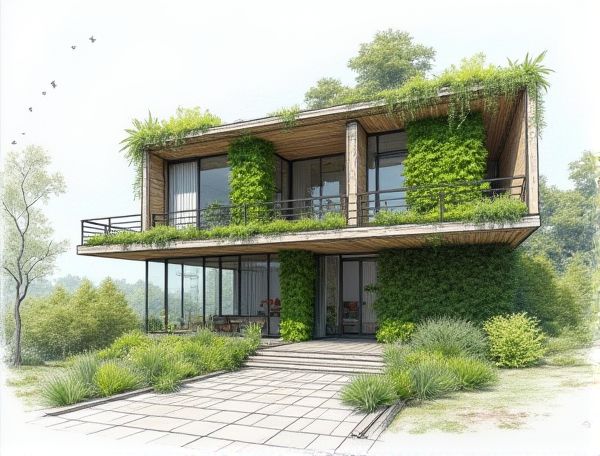
Photo illustration: Biophilic home design with integrated living green walls
Incorporating biophilic home design with integrated living green walls enhances air quality and creates a natural, calming environment that supports your well-being. Discover how these innovative green walls can transform your living space by reading more in the article.
Introduction to Biophilic Home Design
Biophilic home design integrates natural elements, such as plants, natural light, and organic materials, to create a calming and health-enhancing living space. This approach improves air quality, boosts mental well-being, and fosters a deeper connection between You and your environment. Embracing biophilic principles transforms Your home into a sanctuary that harmonizes nature with modern living.
The Science Behind Biophilia and Wellbeing
Biophilia, the innate human connection to nature, enhances your wellbeing by reducing stress, improving air quality, and increasing productivity through natural light and greenery integration in home design. Scientific studies show that incorporating biophilic elements like plants and natural materials can boost mental health and create a harmonious living environment.
What Are Integrated Living Green Walls?
Integrated living green walls are vertical garden installations designed to incorporate living plants within the architectural structure of a home, enhancing both aesthetics and indoor air quality. These walls utilize advanced hydroponic or soil-based systems to sustain plant life, promoting natural insulation and biodiversity inside living spaces. By seamlessly blending greenery with interior design, integrated living green walls contribute to energy efficiency and provide psychological benefits through increased contact with nature.
Key Benefits of Living Green Walls in Homes
Living green walls in homes improve indoor air quality by filtering pollutants and increasing oxygen levels while providing natural insulation that reduces energy costs. These vertical gardens also enhance aesthetic appeal, boost mental well-being, and promote acoustic comfort by dampening noise.
Designing a Biophilic Home: Essential Principles
Incorporating natural elements such as indoor plants, natural light, and organic materials enhances well-being and connectivity with nature in biophilic home design. Emphasizing spatial layouts that integrate outdoor views and promote airflow supports a healthier, more sustainable living environment.
Selecting Suitable Plants for Indoor Green Walls
Selecting suitable plants for indoor green walls involves choosing species that thrive in low to moderate light and require minimal maintenance, such as pothos, ferns, and spider plants. These plants improve air quality and add vibrant greenery, creating a natural focal point in your home design. Ensuring proper irrigation and humidity control helps maintain the health and longevity of your indoor green wall.
Integrating Green Walls into Different Home Spaces
Integrating green walls into your living room, kitchen, or bedroom enhances air quality while creating a natural focal point that boosts aesthetic appeal and tranquility. Vertical gardens serve as sustainable design elements that improve insulation, reduce noise, and promote well-being by bringing nature indoors.
Maintenance Tips for Healthy Living Green Walls
Regularly inspect green walls for pests or diseases and prune plants to promote healthy growth and air circulation. Ensure consistent watering with a drip irrigation system and use eco-friendly fertilizers to maintain vibrant, sustainable green walls that improve indoor air quality.
Overcoming Challenges in Biophilic Design
Integrating biophilic design in homes involves overcoming challenges such as spatial limitations, cost constraints, and maintaining natural elements in urban settings. Effective solutions include using modular green walls, incorporating natural materials like wood and stone, and maximizing natural light through strategic window placement. Prioritizing indoor plants that thrive in low-light conditions ensures year-round greenery and improved air quality, enhancing both aesthetic appeal and occupant well-being.
Future Trends in Biophilic Home Design and Living Walls
Future trends in biophilic home design emphasize integrating living walls to enhance indoor air quality and promote mental well-being by connecting Your living spaces with nature. Advances in smart irrigation systems and modular vertical gardens enable easy maintenance and customization, making living walls more accessible and sustainable. Incorporating these green features can increase property value and create healthier, aesthetically pleasing environments in modern homes.
 homedesy.com
homedesy.com